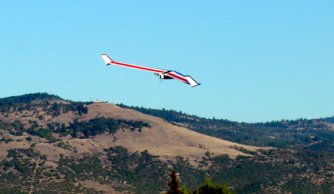
#9 FLYING
CG: (with 19 inch total measured sweep distance) about 1/2" to 3/4" behind rear spar.
Start with it about 1/2" back from the rear spar and test glide to check trim.
Be ready on the stick to make quick adjustments for that first test glide.
Having someone else throw it helps, and a little steady breeze makes a big difference as well.
Once trim is adjusted for a nice level glide, note the elevon travel when
trims are adjusted back to center on the ground.
Mechanically adjust (or program) this amount out so at center trim your control
surfaces are where they were when you landed.
Once adjusted to be flyable (power off still), feel it out with shallow
turns always back into the wind, and keep your speed up.
Keep gliding it this way for awhile before moving the CG back any more, and
then only very small amounts at a time to test.
Notice if any of the following are evident:
Does it seem to fly like a dog needing tons of up stick to keep it level?
- CG is too far forward!
Can you slow it down to a mush with full back stick and it still won't stall
(or even flare)? - CG is too far forward!
Nose drops hard in turns? - CG too far forward!
Does it yaw all over the place and won't settle down in level flight without
constant pitch trimming needed? - CG is too far back!
You want to start a little forward and work your way back until it suddenly
seems to "get up on the step".
It will become much more responsive, seem to glide forever, and even fly
faster than before.
This is because with a nose heavy condition, although seemingly more stable,
you need lots of up elevon to balance it in level flight.
This requires the wing to fly at a higher A of A and therefore has much more
drag.
This also causes tip stalls since the wing is already at a high A of A before
you apply control deflection.
Once the CG is back to that sweet spot, don't go any further back or Wally
will bite you the other way!
Remember, the ENTIRE safe CG range on the Wally Wing is not much more than
1/2 inch TOTAL!
For new flying wing pilots, the biggest problem you will have is over control
and flying too slow.
Add to that an out of range CG location and you'll got real problems.
This always results in a "tip" stall where one wing suddenly drops out of
the sky and the plane enters the dreaded "death spiral" dive that usually
cannot be recovered from in time to avoid hitting the ground.
Set your aileron travel to near twice the elevator at first on a programmable
system. (DR and EXPO is helpful here) and limit total travel of both together
to 100%. (60% ailerons, 40% elevator for example)
If using a non programmable transmitter, set the servo arm link connection
on the lowest hole that doesn't bind and set the control surface connection
on the most outer hole of the horn. This will reduce the overall travel to
the control surface.
Even then you'll only use about 1/4 of the stick range for normal flight and
about 1/2 travel for aerobatics.
Full travel will probably bind the push-rods at full deflections (i.e. full
up and right stick) due to the adding of the travels from the mixed controls.
There has already been one injury reported caused from launching with the
power on.
ALWAYS have the throttle off, toss in a level glide and then punch it!
Fingers can't be replaced at the field :)
Conclusion
We could (and still might) write a book on the Wally World 'O' Wings.
For now, this should get you up and Wally Wing'n it in no time!
I hope you'll get as many hours of flying enjoyment from your Wally Wing as I do!
Once you are flying, we want to find out how you like your Wally.
Also pics (jpg or gif) are needed for the Gallery page that's coming.
As always, any comments, suggestions, etc. are always welcome!
Sincerely;